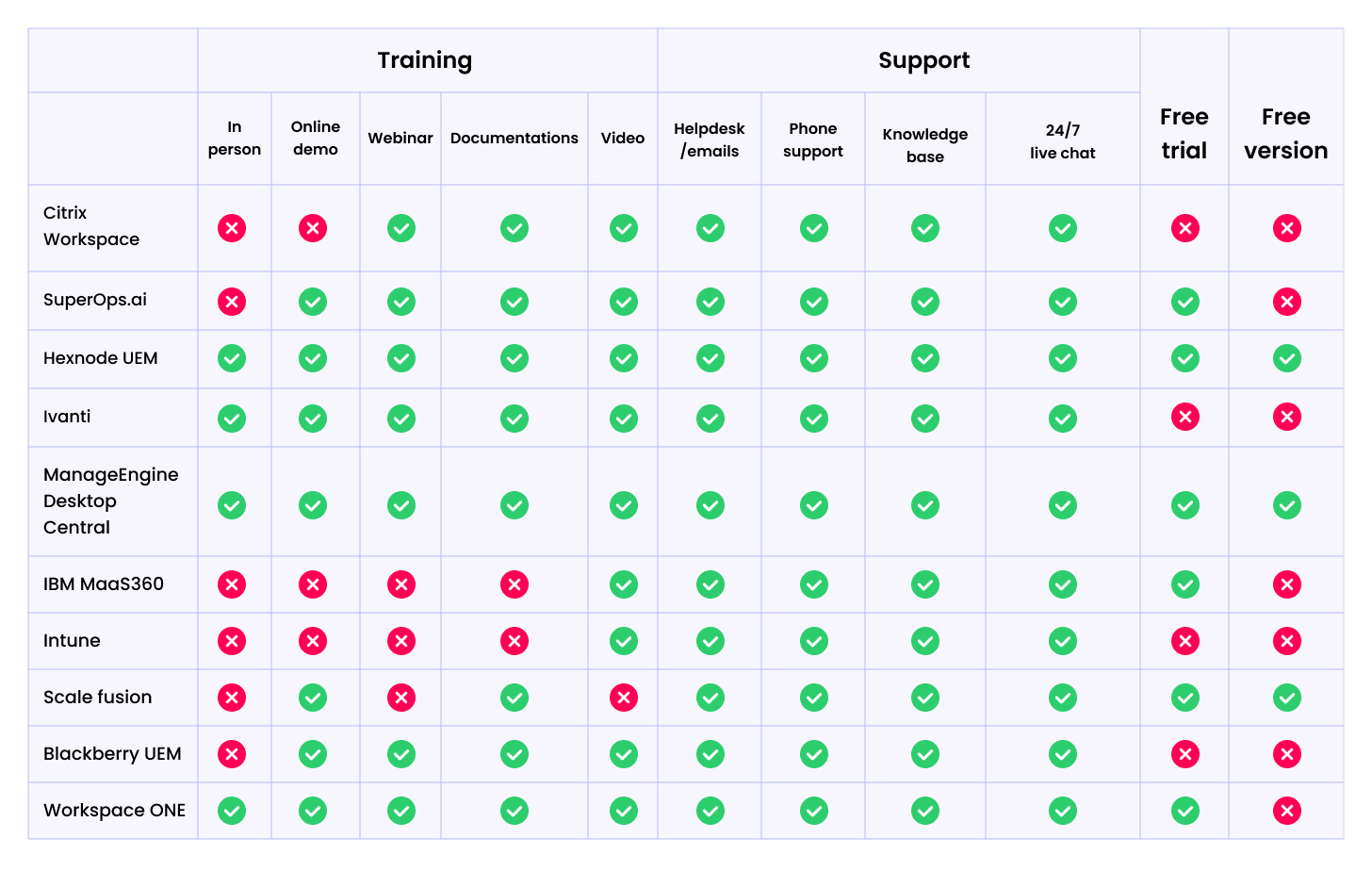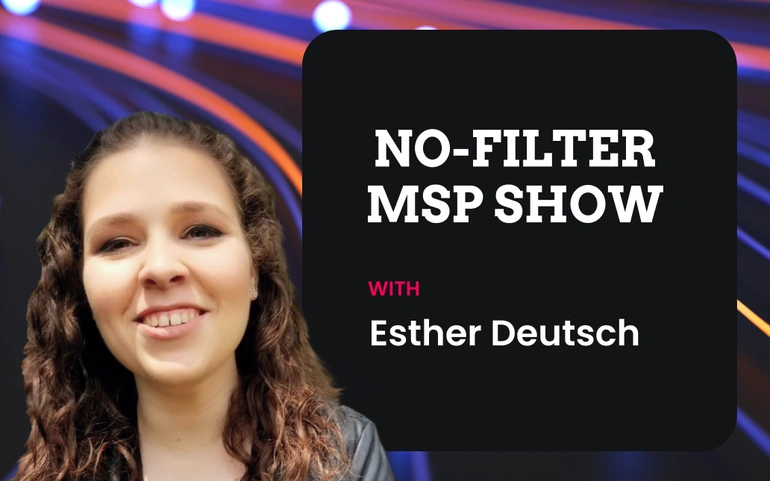The 10 best UEM software in 2022 ranked
So you’re an MSP looking for the best UEM software in the market. No brainer right - whichever software with the highest rating is the best one. Or is it?
SaaS is a crowded market, with over 93,000 products and 1.5 million reviews listed on G2 alone.
Best is a broad term. After all, even Aston Martin can’t beat Ferrari’s zero to sixty and Ferrari can't beat Aston Martin’s sleek interiors. Each car is the best in its own league. An easier question would be what is the best UEM software for your business, and how to narrow down your choices in a cluttered SaaS solutions market.
As a managed service provider, your clients rely on you to monitor a multitude of their endpoints scattered across locations, devices, operating systems, applications, and servers. They want to give employees control over the device they use to work, so they use whatever empowers them to be their most efficient selves.
The need for a comprehensive solution that can remotely monitor and manage all endpoints in one place while preserving the user experience was what led to the genesis of Unified Endpoint Management (UEM).
Since then, MSPs have come a long way. They’ve built an effective ecosystem management strategy, helping enterprises maintain access, management, and security for a diverse portfolio of endpoints, while creating better experiences for endpoint users.
Creating visibility and applying consistent security policies across a diverse array of endpoints would be no mean feat. Perfect use of unified endpoint management relies on ensuring:
- the devices are monitored all the time for full health,
- any anomaly is spotted and rectified immediately so work doesn’t halt,
- security is failsafe even when the endpoints are divided by location and type, and
- the tool is easy to use and the UX is seamless no matter its complex offerings.
In other words, any UEM solution you choose should fulfill all of these requirements.
When we were building our own UEM software, we decided to have a look at the existing products in the market. We wanted to understand what they have done well so we learn from them, and what gaps they have in their product so we fill them.
We started with the popular ones—Citrix Workspace, Hexnode UEM, Ivanti, ManageEngine Desktop Central, IBM MaaS360, Microsoft Intune, Scalefusion, BlackBerry UEM, Workspace ONE.
By trying the products ourselves and by scouring through hundreds of user reviews, we understood the advantages and shortcomings of each one. That’s when it struck—why not put our findings together to help you in your search for the best UEM tool?
Keeping the search for the “best” software aside, which is anyway subjective, we decided to rank the tools based on factors that might influence your buying decision.
- Value for money
- Feature availability
- User interface
- Quality of support
- User experience and onboarding
- Integrations
But before we dive deeper, let’s go over a quick introduction to all of the tools, along with our own resident product, SuperOps.ai.
- SuperOps.ai is focused on delivering better IT experiences with a unified PSA-RMM platform. With a focus on a human-centric user interface and comprehensive endpoint management, SuperOps.ai strives to give complete process visibility and seamless user experience to MSPs.
- Citrix Workspace positions itself as an all-in-one workspace solution that helps manage a secure hybrid work environment. Every feature they offer circles back to security and simplicity.
- Hexnode UEM is one of the specialist products in the mobility management space, offering a range of features, including zero-touch deployment and enterprise-ready integrations. They charge per device, which can be unsustainable in a remote work environment where people use uncountable devices. They also have quite some work to do on the integration side.
- Ivanti is an automation-led unified endpoint management solution designed to eliminate the complexity involved in remote device management. Word out there is they provide a good customer experience.
- ManageEngine Desktop Central claims to be a modern take on traditional device management, with more depth and customization. The learning curve is pretty short and the tool is easy to use. However, they don’t offer a free trial, so you might not be able to try how the product fits into your use cases.
- IBM MaaS360 is an affordable UEM software capable of providing remote management in a zero trust security environment. MaaS360 lets companies rapidly scale their workplace with disruption-free remote monitoring. But the non-intuitive user interface has always been a concern for its users.
- Microsoft Intune is a cloud-based UEM tool with simplified inventory management and policy enforcement offerings. But just like its peer software MaaS360, Intune has to work on its slightly outdated UI.
- Scalefusion offers a clutter-free dashboard for endpoint visibility and extends training and consultancy services for easy onboarding. The features are streamlined to provide as little or as much control over kiosked devices, making the solution suitable for healthcare with staff in field locations. Their conditional access is somewhat basic and for a solution with scalability claims front and center, the solution mandates buying a bunch of licenses to maintain different endpoints.
- BlackBerry UEM is a comprehensive endpoint solution with flexible migration and deployment capabilities. The tool eliminates the hassle of reactivation when moving from on-prem to cloud models.
- Vmware Workspace ONE promises to optimize IT experiences for modern-day MSPs with a focus on scalability. Their support is easily accessible on a number of channels including knowledge base, live chat, emails, and they also offer in-person training to users.
We found other solutions like Miradore and Meraki, which are one step closer to a robust unified endpoint management solution—but a long step at that. So we will go with the above UEM software solutions.
Your search for the best UEM software ends here. |
Let’s dive into our comparison.
Value for money
Budget is the easiest area to start with. When buying anything, we set a budget based on what we assume the product is worth and what is the average minimum price of the product. Budget saves a lot of time by filtering out products you won’t buy no matter how good they are. The commonly used pricing models are:
- Per-user pricing - Depends on the number of users monitoring the endpoints on the MSP side.
- Per-device pricing - Depends on the number of customer endpoints that are monitored.
- Custom pricing - Depends on several permutations and combinations that are not always transparent or trackable. Differs from brand to brand.
Per-user and per-device pricing are the most preferred as these are set in stone. Custom pricing requires you to get a quote depending on your unique requirements, which may bump your prices up. They may charge a fee for installation, which should typically be free of cost.
Ivanti and Blackberry UEM fall in the category of custom-pricing solution providers. They don’t mention prices anywhere in the product and mandate you to request a quote if you want. However, Ivanti has commendable benefits like easy project rollouts, agentless scans, and flexible software distribution. But you have no way of knowing what the other clients are paying and how much or how little you’re paying for your use case.
Here’s a cost comparison graph using the prices we found on the respective website. Please note that the prices are subject to change, please check websites for updated prices before making a decision.

For comparison, we will look at their highest plan and the corresponding pros and cons.
Citrix Workspace pricing can vary based on your type of contract. Price is less if you choose a three-year contract as opposed to a one-year contract. Citrix Workspace is one of the popular UEM software products, with good patching mechanisms and remote work optimizations. But the bandwidth for scalability needs significant work, as many user reviews point out the software becomes heavy and difficult to use as you start adding more endpoints. So Citrix Workspace is good for SMBs with relatively fewer endpoints to handle.
Designed with all of these pain points in mind, SuperOps.ai is an agile UEM solution with an easy learning curve. The dashboards are fun to use and SMBs looking for an affordable solution with easy visibility have all the more reason to go for SuperOps.ai.
ManageEngine Desktop Central and Workspace ONE provide a hybrid pricing model. Most people who switch to ManageEngine Desktop Central from their existing service providers cite ease of use, cloud offerings as opposed to on-prem solutions, and more aligned features as reasons. However, according to user reviews, their support is very slow to respond. Apparently, their out-of-date documentation doesn’t help much on the self-service side as well.
At $3.78 per user, Workspace ONE is more affordable than Citrix Workspace and ManageEngine Desktop Central. The software is fairly easy to use. Many customers say that the initial implementation takes a considerable amount of time and requires significant manual configuration. You can go for it if you have the bandwidth and resources.
Ivanti doesn’t have transparent pricing and there are a few complaints of hidden costs being added. Scalefusion offers really good customer support and their dashboards are good to use. Their Mac expertise has room for improvement, and so does Hexnode UEM’s Android expertise.
Please bear in mind that inexpensive isn’t always the best. Blackberry UEM, even though custom-priced, is said to be cheaper when starting but can get really expensive as you start adding features. Think long-term, think scale, and choose a UEM platform you won’t grow out of any time soon.
Feature availability
You set your budget with some considerations in mind - “If I pay this much I will get these many features”. In order to not lose any prospects due to cost limitations, some companies market their product as affordable—but spike up the cost elsewhere, by charging where their competitors don’t.
Although Citrix Workspace starts at $2 and $7 per device per month for the essential and standard plans respectively, the features these two plans offer are fairly minimal from a UEM standpoint. Device and OS management including macOS and ChromeOS only come under the premium and premium plus plans, where the per-device costs are $18 and $25 respectively.
If you need the actual capabilities of a unified endpoint management tool, you can’t go for their essential or standard plans, as these only include basic features like single sign-on and multi-factor authentication. We see this common trend with some products, where they charge for features that usually come as a package.
Analyze the number of features each product offers for the same cost and whether certain features come bundled or as add-ons.
In terms of feature availability, fewer products in this list stand out. Many of them are more RMM than UEM still, so that eliminates a fair number of tools. Citrix Workspace, ManageEngine Desktop Central, and SuperOps.ai are extensive in the feature offerings, even in tier-1 and tier-2 plans. Hexnode UEM is one step away from becoming a good contender in feature availability. They will get there once they make their Android support as strong as their Mac support.
User interface
The user interface would come first in the list of important things to look for if money wasn’t an issue. Your user interface is where business happens. It is where curious visitors turn into paying customers. A user scrolling through your interface and bouncing to another tab unimpressed is basically the online equivalent of your brick-and-mortar shop visitors walking out the door after taking one look at what you’ve got.
Something put them off; it could be low responsiveness, inconsistent claims, low credibility, or non-intuitive interactions. A tool with any of these drawbacks is a no-no.
The user interface decides the experience your users have interacting with your product. And it’s the interface—from a drop-down icon to the functional dashboard—that decides how the experience will be.
The user interface is hands down the forte of SuperOps.ai. Highly user-centric and intuitive, the SuperOps.ai interface puts user experience first. Starting with things as simple as placing one click where there are usually two, our product designers put a lot of thought and research into making the experience hassle-free for users.
Training and support
Even if a company offers the best product at the best price, without quality customer support, you will have a hard time using the product. It’s on the customer support to handhold you should you bump into an issue or you need help using the product to its maximum potential.
You don’t want to be staring at an engaged phone screen while your server is shutting down.
Also, what training do they provide? You can’t benefit from the best software in the world if your users don’t adopt it. How does the brand help in ensuring user adoption?
Look at the table below where we have compared all the UEM software based on what channels they provide support in and how extensive is their training process.
We have also mentioned if they provide a free trial, which is essential considering you need to know how the product suits your use cases and goals before making the final decision.

(Source: Capterra)
Citrix Workspace has a generous free trial and usually gets accolades for customer experience.
Hexnode UEM, SuperOps.ai, and Workspace ONE have highly responsive customer support teams as well, with quick turnaround times and easy access to resources.
SuperOps.ai is the one-stop shop for all your UEM needs! |
The 10 best UEM software ranked
Rank | UEM software | Why use? |
1 | Citrix Workspace | Extensive features. Gets slightly heavy while scaling. Suitable for SMBs. |
2 | SuperOps.ai | Competitive price, intuitive UI, industry-first intelligent alerting. Suitable for SMBs. And the best of all—a 50% discount offer for a limited time! |
3 | Scalefusion | Good for SMBs, particularly good at managing Android devices. |
4 | Hexnode UEM | Seamless onboarding, particularly good kiosk device management. Hexnode UEM for Windows can be as good as Hexnode UEM for Mac. |
5 | Intune | Good Android support, and affordable. Can fit enterprise needs. |
6 | ManageEngine Desktop Central | Better feature alignment, better ease of use. Suitable for enterprises. Needs work on customer support. |
7 | Vmware Workspace ONE | Better price per user, suitable for MSPs with both Mac and Windows endpoints. The standard edition has the most necessary features. Implementation time can be improved. |
8 | IBM MaaS360 | Good compliance policies, fairly affordable. Outdated UI slows down process flows. |
9 | Ivanti | Designed for SMBs. Pricing can be more transparent. You can try for a good quote. |
10 | Blackberry UEM | Affordable for SMBs who’re just starting. Price ramps up while adding new features. |
How SuperOps.ai edges out
When we started building our UEM software, we asked ourselves, what can one more software do when there are countless ones out there already?
How do we make ours better?
We want our offering to be the best of both worlds—the reliability of legacy products and the novelty of new-gen products. In the process, we found gaps we could fill—solutions like Intune and MaaS360, although strong on the feature side, have user interfaces that are outdated and feel heavy.
We found most solution providers still follow reactive problem-solving. Thus our industry-first intelligent alerting feature was born, to ensure you stay on top of the process all time, anytime. This is just scratching the surface of what we are doing and planning to do to make sure we deliver rich user experiences.
Modern-day MSPs badly want a UEM tool that can catch up with their fast-evolving, technology-driven requirements. SuperOps.ai is built with this requirement in mind through and through, and it shows.
Frequently asked questions
We have them answered.
Try the only truly unified UEM software.
Looking to make your endpoint management hassle-free? Look no further than SuperOps.ai


